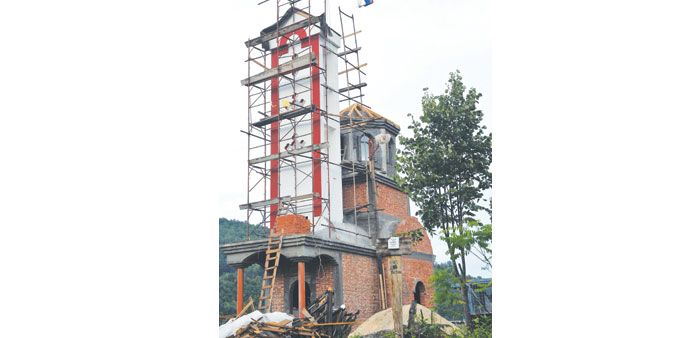The bell tower of a Serbian Orthodox church under construction in Budak near the eastern Bosnian town of Srebrenica.
By Rusmir Smajilhodzic, AFP/Srebrenica
On a forest-covered hill near Srebrenica, a white bell tower rises into the sky, giving the first glimpse of a new church being built near the scarred Bosnian town, which this week marked the 18th anniversary of the worst massacre in post-war Europe.
But instead of bringing peace and calm, the Orthodox Christian church has sown fresh discord in the ethnically mixed town, which still bears the deep scars of the 1992-1995 Bosnian war.
For the local Bosnian Serb population, the church, built just a few hundred metres above a memorial centre for the victims of a genocide, is a necessity.
For the victims’ families and the international community, the new church is pure provocation.
According to Hatidza Mehmedovic, a Bosnian Muslim and head of an association grouping Srebrenica women who lost loved ones in the 1995 massacre, the “mere fact that the church is being built does not bother us”.
But the church “is at a spot where there are no believers and just near the site of a mass grave” where victims of the massacre were found, she said.
Mehmedovic’s husband and two sons, killed in the atrocity, are buried at the memorial cemetery at Potocari, just outside Srebrenica.
Aleksandar Mladjenovic, a local Orthodox priest who has been supervising the construction work, said that the builders had reduced their work at the site ahead of the July 11 anniversary of the massacre “to avoid tension”.
On a warm July evening, only the chirping of birds and the fluttering of a Serbian flag on the bell tower break the silence around the church, in the small village of Budak.
Nearby is a flat, freshly mown field surrounded with a barbed-wire fence: this is the site where in 2007 forensic experts exhumed the remains of some 130 victims of the Srebrenica massacre.
“They are building (the church) at this spot as a provocation to the dead and the victims’ families,” said Mehmedovic.
Her head covered with a white veil, Mehmedovic points to thousands of white grave stones at the Potocari memorial centre.
Among them are the graves of some 409 massacre victims, identified since the last anniversary, that were buried on Thursday.
The dead were laid to rest alongside the 5,657 other victims found in several mass graves in the Srebrenica region who were already buried there.
A few months before the end of the Bosnian war, Bosnian Serb forces captured Srebrenica, a UN-protected Muslim enclave, and loaded thousands of men and boys on to trucks.
Over several days in July 1995, they executed some 8,000 of them and then threw their bodies into mass graves.
Two international courts have ruled the massacre, the worst atrocity in Europe since World War II, a genocide.
Before the war, Srebrenica was a sleepy mining town home to some 37,000 people - 80% of them Muslims.
Nowadays, only 6,000 people live in the town, around half of them ethnic Serbs, while for Muslims, the town has remained a gruesome symbol of their wartime suffering.
Mehmedovic insists that the first Serb-populated hamlet is between 2km and 3km from the new church.
“Serbs laugh in the face of victims and rub salt into our incurable wounds,” she said bitterly.
Mladjenovic insists here were no “ill intentions” in choosing the site. He says it was simply a lack of alternative options as the church had “no means” to buy land for construction.
“In 2010, one local inhabitant offered this land to the church. This is not a political church, or a church to provoke. People want it,” he said.
Locals gave their own money for building material and “come to work for free” to lend a hand in the process, he added.
But the church has also annoyed international officials in Bosnia who, along with Srebrenica’s Muslim mayor Camil Durakovic, called on Serbian Orthodox Church to halt the construction work and look for another site.
“This church’s location far from a sizable human settlement and so close to a former mass grave and the Srebrenica Genocide Memorial is one designed to provoke rather than to serve the legitimate needs of the faithful,” a statement from the US embassy in Sarajevo said.
Durakovic said the Srebrenica town hall was prepared to fork out for new land to “move” the church there, and away from Budak.
“This is a battle on the sacred land, because the memorial is a sacred place for Muslims,” Durakovic says.
But for Mladjenovic, the church is not seeking to cause offence. “A crime is a crime, a victim is a victim and as far as we are concerned they are respected,” the priest said.

